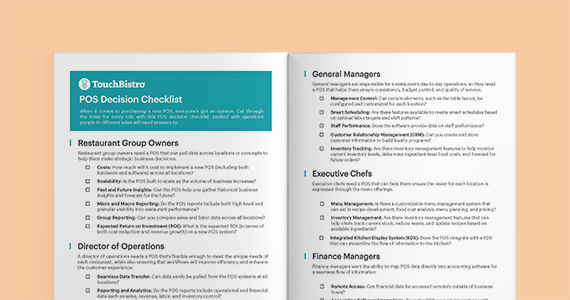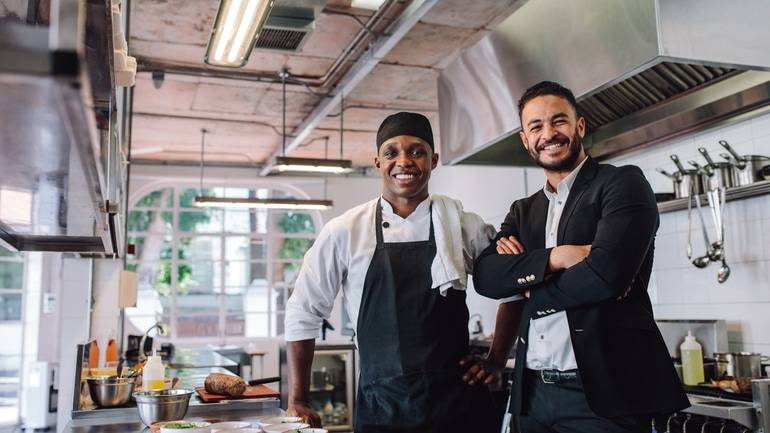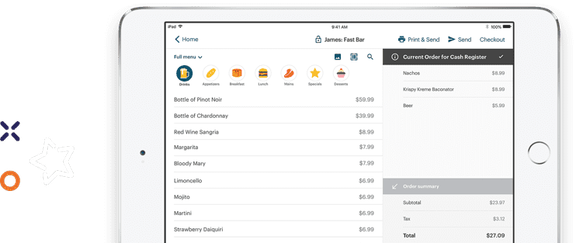Your POS purchase is one of the most important decisions for any restaurant – especially if you plan on expanding your business.
Thanks to a host of smart features, a modern POS can help you improve everything from the customer experience to the bottom line. According to data from TouchBistro’s 2020 State of Restaurants Report, today’s restaurant owners use POS reports most often to make decisions about menu pricing, scheduling, menu design, and more. That’s a lot riding on one system.
With such a big decision on the table, you’ve got to cover all your bases before making a POS purchase. Remember, you’re not the only one who will be using the restaurant POS, so you need to make sure that the system you choose covers the needs of all the individuals (the stakeholders) involved in your restaurant – from the owner to the chef.
But here’s the tricky part. Too many opinions on a new POS is like having too many cooks in the kitchen – things can quickly get out of hand. That’s why it’s important to narrow down who should weigh in on your POS purchase and what their wish list entails.
To help you navigate the challenges of a new POS purchase, we’ll dive into the question of who should be in the room for the decision, including:
- Key considerations when making a POS purchase
- How to identify and prioritize key stakeholders
- How to get buy-in from stakeholders
- Key stakeholders and their primary considerations
- A free checklist of top purchasing points for each stakeholder
Already started the POS buying process? Download our Ultimate POS Decision Checklist.

Who should (and shouldn’t) weigh in on your POS purchase? Make sure all the opinions you’ll want to consider are getting their needs met with this checklist.
3 Key Considerations When Making a POS Purchase
Today’s POS systems do a lot more than simply process orders and sales. Modern POS systems often serve as end-to-end restaurant management tools that handle everything from inventory management to reporting and analytics. These systems are designed to save you time, and streamline and simplify all aspects of restaurant management – something that’s particularly important for multi-location restaurant groups.
But with so many providers offering these all-in-one systems, it can be tough to know which is the right one. Each provider has different capabilities and strengths, which is why it’s important to ask the right questions in order to find a POS that fits your restaurant, whether that’s TouchBistro vs CAKE POS.
When narrowing down your POS options, there are a few must-haves that should be top of mind
1. Type of System
When researching different providers, you’ll likely be faced with three types of POS systems: server-based, cloud-based, and hybrid.
A server-based system stores all your sales data on local servers and runs on a closed internal network. These kinds of systems have largely fallen out of favor because your data can only be accessed on-premise and you need to bring in a technician each time a repair or upgrade is required.
A more modern type of POS is a cloud-based system, which stores all your data in the cloud via remote servers. While the cloud gives you the freedom of a mobile POS, the downside is that all the features become useless if you lose the Internet.
When researching different systems, it’s important to look for a hybrid POS that gives you the flexibility of the cloud with the security of your own network. This ensures that even if your Internet connection goes down (it happens!), your restaurant won’t experience any downtime.

2. Ease of Use
First and foremost, the POS system you choose needs to be easy for everyone to use – from servers to restaurant owners. This means that the system should be intuitive and information should be laid out in a logical format.
While training is necessary for any new POS, newbies should still be able to get the hang of things pretty quickly. If not, it may be too complicated a system!
If you choose a system with a steep learning curve, you’re bound to have ongoing problems, especially if you plan on expanding your business.
3. Setup, Support, and Training
Making a POS purchase means entering into a long-term relationship with a new provider. With that in mind, you want to select a provider that will be able to fully resolve problems in a timely manner. As you already know, restaurants need to function with minimal interruption – even a brief delay or minor glitch is enough to erode the guest experience.
When narrowing down your list of potential providers, look for one that provides detailed training and guarantees ongoing support – preferably 24/7. This is particularly important for restaurant groups that may need to set up and train hundreds of employees on a new system.
Though there are other deciding factors when it comes to your POS purchase, the above are must-have features that can help you narrow things down.
Involving Key Stakeholders
Using the criteria above will help you to whittle down your list of possible POS providers from dozens to just a handful.
It’s important to narrow things down before approaching other stakeholders because too many options can quickly lead to decision paralysis – just think of how hard it is to choose an entree when you have too many options!
Identifying Your Stakeholders
Once you’ve narrowed down the POS systems that will meet your basic needs, it’s time to narrow down your stakeholders.
A stakeholder is any person who:
- Is responsible for major agreements or final decisions
- Is in a position to implement or block the decision
- Has expertise or information crucial to realizing the desired outcome of the decision
- Is likely to be affected by the outcome (either positively or negatively)
- Will need to be informed of the outcome
It’s important to identify all stakeholders before you begin building a business case for your POS purchase. Technology purchases – especially those that involve replacing outdated systems – require acute awareness of all the individuals that will be impacted that the change. This includes everyone from end users such as servers, to executive stakeholders such as restaurant group owners.
Prioritize Your Stakeholders
Once you’ve identified your stakeholders, it’s important to work out how much influence they’ll have over the final POS purchase decision, how involved they’ll be in the project, and their ability to implement or block decisions.
Though everyone in your restaurant will be impacted by your POS purchase to some degree, it’s important to establish a hierarchy of stakeholder importance. At the top will be the critical individuals who have the highest influence and highest interest, while those with lower influence and interests will fall below.
For instance, if your restaurant is a small operation, the restaurant owner may be the stakeholder with the most power to determine the project’s outcome, while the manager will have less influence. However, larger restaurant groups may have a few high influence stakeholders, such as the owners and director of operations.
While every restaurant is different, this exercise will help you determine exactly who should weigh in on your POS purchase.
Getting Buy In from Stakeholders
Once you’ve identified and prioritized key stakeholders, you’ll need to get buy in from each individual. Before you let the jargon scare you, getting buy in simply means getting the different stakeholders on your side.
To get buy in, introduce potential POS options to stakeholders and then listen to their feedback. At the same time, make sure that all stakeholders understand the goals and desired end results. The more information you gather, the easier it will be to put together a case for a new POS that addresses all stakeholder concerns and interests.
To help you in the process of involving key stakeholders in your POS purchase, we’ve outlined the primary considerations for each restaurant role – we’ve even created a handy checklist for easy reference!

Top Purchasing Points for Each Stakeholder
For restaurants and restaurant groups, choosing a new POS system is a bit like a family choosing a new car. The teenage daughter wants an updated sound system, while Mom is focused on gas mileage and Dad is concerned with safety features – each person has their own criteria.
It’s the same idea with a POS purchase. A restaurant manager would want something that is easy for staff to use, while business owners are focused on the bottom line. Though some individuals will have more influence than others, it’s important to know the key consideration for each of the stakeholders involved in a POS purchase.
Of course, every restaurant and restaurant group will have a slightly different organizational structure, but the breakdown below will give you a good idea of the different priorities for some key stakeholders.
Restaurant Group Owners
Restaurant group owners are responsible for the growth and development of the restaurant group’s portfolio, driving a greater experience for guests, and bolstering the profitability of the business.
With multiple venues to keep track of, restaurant group owners need a POS with robust reporting and analytics that can help inform strategic business decisions across different locations. For instance, keeping tabs on revenue while controlling prime costs becomes increasingly complex as you’re expanding your business.
As a result, restaurant group owners are focused on the following when choosing a new POS:
- Overall costs (hardware and software)
- Scalability
- Past and future business insights
- Micro and macro reporting
- Group reporting
- Expected return on investment
Director of Operations
No two restaurants operate the same way, even within the same restaurant group.
The role of a director of operations – or operations manager – is to streamline operations across locations and concepts. This means that they want a system that’s flexible enough to meet the unique needs of each restaurant, while also ensuring that POS workflows will improve efficiency and the customer experience at each location.
Some key considerations for director of operations can include:
- Seamless data transfer
- Reporting and analytics
- Remote capabilities
- Custom permissions for different roles
- Integrated payment processing
General Managers
While the director of operations thinks big picture, general managers are responsible for an individual restaurant’s day-to-day operations and ensuring that the venue is in line with the restaurant group’s vision and values.
The general manager essentially serves as the glue between the restaurant group and the employees, with duties ranging from training new staff to leading initiatives that help grow the business.
For general managers, this means looking for a POS with features like:
- Customizable management controls
- Smart scheduling
- Staff performance
- Customer relationship management tools
- Inventory tracking

Executive Chefs
Executive chefs work with back-of-house staff to ensure that the vision for each location is expressed through the menu offerings. In other words, the executive chef is responsible for all aspects of the food that comes out of a restaurant’s kitchen – responsibilities that are directly tied to the POS system.
For instance, if each location has specials that change daily, there needs to be an easy menu management system in place.
With these considerations in mind, executive chefs generally look for POS features related to the culinary aspect of each venue, including:
- Menu management
- Inventory management
- Integrated kitchen display system (KDS)
Finance Managers
When it comes to making a POS purchase, finance managers are all about the numbers.
The POS is the primary source for all of a restaurant’s revenue and cash, so finance managers look for a system with powerful accounting integrations. This means that data flows directly from the POS to the accounting software, ensuring that a restaurant’s operational and financial data is always in balance. It also helps to reduce the time and errors that come with manual data entry.
With this in mind, finance managers look for the following POS features and app integrations:
- Remote access
- Accounting software integrations
- Payroll integrations
- Financial reporting
Restaurant Managers
Finally, managers of individual restaurant locations have unique insight into how front-of-house staff will use the POS.
They’re the ones who know the staff’s specific needs, pain points, and deal-breakers when it comes to implementing a new POS. Generally, their priority is a system that is easy for staff to use and helps to deliver the highest quality customer experience.
This means looking for features such as:
- Restaurant table management
- Staff management
- Tableside ordering
- Seamless comps, voids, and refunds
Though it may seem overwhelming to consider the wants and needs of so many different people, simply involving other stakeholders in the buying process can help to prevent major issues down the line.
At the end of the day, a team that’s happy with its technology is one that’s setting itself up for success.

Who should (and shouldn’t) weigh in on your POS purchase? Make sure all the opinions you’ll want to consider are getting their needs met with this checklist.






